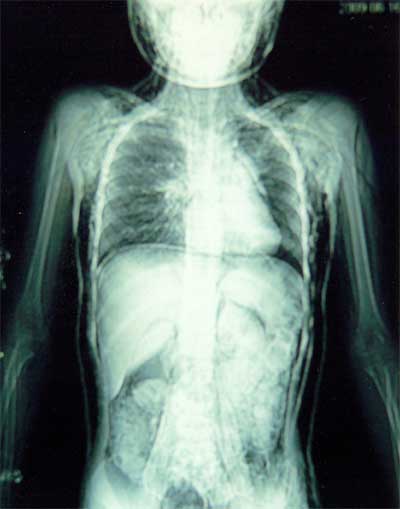|
|
|
Indian Pediatr 2011;48: 647-648 |
 |
Pressurised Air Injury in a Child |
|
V Poovazhagi, S Thangavelu and S Shanthi
From Pediatric Intensive care Unit, Institute of Child
Health and Hospital for Children, Egmore, Chennai, India.
Correspondence to: Dr V Poovazhagi, 8/11 Manjolai street,
Kaliamagal Nagar, Ekkaduthangal, Chennai 600 032, India. Email:
[email protected]
Received: January 9, 2010;
Initial review: February 11, 2010;
Accepted: May 20, 2010.
|
We report the case of a 7 year old girl, who sustained accidental injury
following injection of pressurized air from a bicycle tyre air nozzle.
She presented with generalized subcutaneous emphysema along with
pneumomediastinum, pneumothorax, pneumoperitoneum, pneumoretroperitoneum
and pneumorra-chis. The child was recovered completely on conservative
management.
Key words: Pressurised air, Pneumomediastinum, Subcutaneous
emphysema.
|
|
A
7 year old girl traveling on the cross bar of a bicycle
accidentally fell, resulting in penetration of her left heel by the
air
nozzle of the front tyre. Following the fall, her heel could be
pulled free from the wheel only with difficulty after 3-4 minutes. A
part of the valve remained attached which was removed later.
Subsequently, the father noted swelling of the left lower limb which
quickly extended to the face. The child started complaining of pain
over the neck and chest . She was taken to a
medical facility within 30 minutes after sustaining the injury.
On arrival, examination revealed generalized
subcutaneous emphysema (involving all four extremities, trunk, face
and scalp). All peripheral pulses were equally palpable; the
capillary refill time was less than two seconds. The respiratory
rate was 62/min without the use of accessory muscles. The oxygen
saturation was 98% in room air. A small puncture wound was present
on her left heel with abrasions of the overlying skin. Crepitus was
present all over the swollen areas. Breath sounds were not clearly
appreciable due to the crepitus. Rest of the systemic examination
was normal.
X-ray chest and abdomen revealed extensive
subcutaneous emphysema, pneumomediastinum, pneumothorax on the left
side, pneumoperitoneum and pneumoretroperitoneum. X-ray of
the extremities and spine revealed extensive dissection of air in
the subcutaneous plane and the muscle plane without any bony injury.
These findings were confirmed by CT of the neck, chest and abdomen (Fig.
1). In addition, air was detected in the epidural space (pneumorrachis)
extending from L3 level upto cauda equina.
|
 |
|
Fig. 1 X-ray showing subcutaneous
emphysema, pneumomediastinum, pneumothorax, pneumoperito-neum
and pneumoretroperitoneum. |
The child was managed in the pediatric intensive
care unit. Complete blood counts, electrolytes, urea and creatinine
were normal. She was administered tetanus toxoid, analgesics, oxygen
and antibiotics.Tachypnea resolved in 24 hours and subcutaneous
emphysema regressed in 48 hours. Auscultation of her chest
thereafter revealed normal breath sounds. She was ambulant by the
third day and discharged on the 7th day without any sequelae.
Discussion
Injection of pressurised air into the
subcutaneous tissue in children is very rare, and usually follow a
benign course [1]. In case of compressed air injury, air accumulates
in the body cavities with minimal tissue inflammation [2]. The entry
site may be deceptively small and painless [3]. The agent involved
and the force of penetration influence the nature of injury.
The air pressure in an inflated bicycle tyre can
vary from 30-60 psi depending on the size of the tyre and the
surface on which it is used. When pressurized air is injected into
the subcutaneous tissue, it can track along the fascial planes to
communicate with the various body-cavities. Air
from the legs and thighs track through the subcutaneous plane and
along the psoas muscle and neurovascular sheaths to enter the
peritoneum and retro peritoneum [4]. Air enters the mediastinum
through the periaortic, periesophageal fascial planes and the
sternocostal attachment of diaphragm. Further, air can dissect in to
the submandibular and retropharyngeal spaces. Air can freely
communicate from the posterior mediastinum or retropharyngeal space
to the epidural space as there is no fascial barrier between them.
It is important to distinguish this condition
from gas gangrene which may present similarly with swelling,
crepitus and air in the subcutaneous tissue and muscular planes .
However, gas tends to dissect into the muscles in gas gangrene in
contrast to the intermuscular planes in air collection [5]. Gas
chromatography may be used to demonstrate the composition of 78%
nitrogen and 21% oxygen in air in comparison to predominantly
nitrogen as seen in gas gangrene
Contributors: VP, ST and SS were involved in
the management, literature search and drafting the manuscript. All
authors approved the final manuscript.
Funding: None.
Competing interests: None stated.
References
1. Klareskov B, Gebuhr P, Rordam P. Compressed
air injuries of the hand. J Hand Surg. 1986;11:436 -7.
2. Ahmadreza A. Pressurised air injection causing
subcutaneous emphysema in a pediatric patient. J Foot Ankle Surgery.
2008;47:66-8.
3. Temple CL, Richards RS, Dawson WB.
Pneumo-mediastinum after injection injury to the hand. Ann Plast
Surg. 2000;45:64-6.
4. Christopher MZ, James RS, George RB, Carl JZ.
Pneumomediastinum revisited. Radiographics. 2000;20: 1043–57.
5. Keun-Bae L, Eun-Sun M, Sung-Taek J, Hyong Yeon
S. Subcutaneous emphysema mimicking gas gangrene following
perforation of the rectum. J Korean Med Sci. 2004;19:756-8.
|
|
|
 |
|

